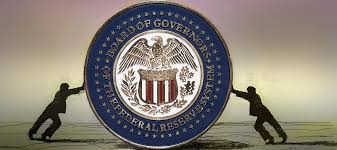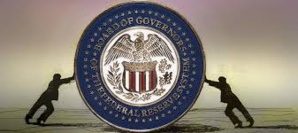Markets are wrestling with the central bank over whether the economy reflects a glass half empty or half full, doubting the Federal Reserve's ability to hike rates as forecast.
The Fed spelled out how it hopes to begin winding down its balance sheet this year and hiked interest rates Wednesday by a quarter point. The Fed expects inflation to stabilize in the medium term and acknowledged low levels of inflation in the near term. The Fed it raised 2017 GDP to 2.2 percent from 2.1 percent and also stuck to its forecast for three interest rate hikes this year.
In its statement and in its plan to move forward with the balance sheet reduction, which the market sees as the equivalent of a rate hike, the Fed was unnecessarily "hawkish", said Krishna Memani, chief investment officer of OppenheimerFunds.
As Federal Reserve Chairwoman Janet Yellen held a briefing after the decision, stocks were trading at lower levels and waffled after the Fed's 2 p.m. announcement.
"What the markets are doing is basically ignoring the Fed, whatever they say. They are basically going off the data and they know eventually the Fed will get around to being sensitive of the data, that will be the driver," said Memani.
After core consumer price index inflation came in weaker than forecast for a third month, Treasury yields, which move opposite prices, had fallen sharply Wednesday. More doubts over whether the Fed can hike rates as it forecasts were raised and spooked the market by the decline in year-over-year inflation to 1.7 percent.
Down from 50 percent Tuesday but up from 25 percent just before the Fed's statement, the expectations for another rate hike this year were at about 35 percent in the fed funds futures market.
While the 2-year yield, reflecting the Fed's rate hikes, rose after the Fed hiked rates to as high as 1.35 percent, yields on the 10-year Treasury note remained near low levels of about 2.13 percent.
"The bond market is saying if they still tighten, it's going to be a problem," said John Briggs, head of strategy at NatWest Markets.
A strengthening consumer and business spending was also cited by the Fed.
"I do wonder if there's a difference in views on the economy developing between the Fed and the markets," said Ed Keon of QMA.
"The Fed pointed to a somewhat strengthening consumer," Keon said. "They're just not looking at the same numbers that I'm looking at, which seem to be coming in a tad weaker. Comparing Q1 to Q2 may look like it's getting a little stronger, but I'm not sure I see consumption accelerating."
With strong hiring and low unemployment but a batch of weak inflation data, the Fed has been in a quandary.
"The market's expectations about inflation may be proven wrong but they would rather be proven wrong than believing whatever the hell the Fed is saying," said Memani.
"The current scenario of low employment and no inflation is actually reasonably positive for growth and reasonably positive for the stock market," he said. "Stock markets are definitely fully priced, but if the economy continues to grow at a 2 percent pace and inflation remains low I think stocks can go up with the growth in nominal GDP."
(Source:www.cnbc.com)
The Fed spelled out how it hopes to begin winding down its balance sheet this year and hiked interest rates Wednesday by a quarter point. The Fed expects inflation to stabilize in the medium term and acknowledged low levels of inflation in the near term. The Fed it raised 2017 GDP to 2.2 percent from 2.1 percent and also stuck to its forecast for three interest rate hikes this year.
In its statement and in its plan to move forward with the balance sheet reduction, which the market sees as the equivalent of a rate hike, the Fed was unnecessarily "hawkish", said Krishna Memani, chief investment officer of OppenheimerFunds.
As Federal Reserve Chairwoman Janet Yellen held a briefing after the decision, stocks were trading at lower levels and waffled after the Fed's 2 p.m. announcement.
"What the markets are doing is basically ignoring the Fed, whatever they say. They are basically going off the data and they know eventually the Fed will get around to being sensitive of the data, that will be the driver," said Memani.
After core consumer price index inflation came in weaker than forecast for a third month, Treasury yields, which move opposite prices, had fallen sharply Wednesday. More doubts over whether the Fed can hike rates as it forecasts were raised and spooked the market by the decline in year-over-year inflation to 1.7 percent.
Down from 50 percent Tuesday but up from 25 percent just before the Fed's statement, the expectations for another rate hike this year were at about 35 percent in the fed funds futures market.
While the 2-year yield, reflecting the Fed's rate hikes, rose after the Fed hiked rates to as high as 1.35 percent, yields on the 10-year Treasury note remained near low levels of about 2.13 percent.
"The bond market is saying if they still tighten, it's going to be a problem," said John Briggs, head of strategy at NatWest Markets.
A strengthening consumer and business spending was also cited by the Fed.
"I do wonder if there's a difference in views on the economy developing between the Fed and the markets," said Ed Keon of QMA.
"The Fed pointed to a somewhat strengthening consumer," Keon said. "They're just not looking at the same numbers that I'm looking at, which seem to be coming in a tad weaker. Comparing Q1 to Q2 may look like it's getting a little stronger, but I'm not sure I see consumption accelerating."
With strong hiring and low unemployment but a batch of weak inflation data, the Fed has been in a quandary.
"The market's expectations about inflation may be proven wrong but they would rather be proven wrong than believing whatever the hell the Fed is saying," said Memani.
"The current scenario of low employment and no inflation is actually reasonably positive for growth and reasonably positive for the stock market," he said. "Stock markets are definitely fully priced, but if the economy continues to grow at a 2 percent pace and inflation remains low I think stocks can go up with the growth in nominal GDP."
(Source:www.cnbc.com)






